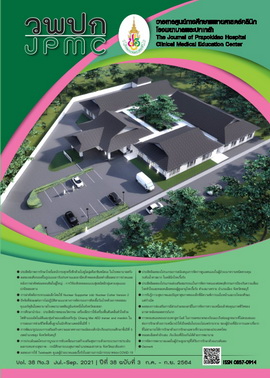Manual Small - Incision Cataract Surgery Using the Nuclear Supporter and Nuclear Cutter version 2
Main Article Content
Abstract
BACKGROUND: Cataract is a common disease in the elderly. Cataract surgery is a very effective treatment. Currently, surgical methods are developed using various instruments.
OBJECTIVE: To evaluate visual acuity and complications in patients undergoing cataract surgery using the nuclear cutter version 2.
METHODS: The prospective intervention study is performed regarding patients with cataract, using the the Kongsap technique. The nuclear supporter and nuclear cutter version 2 was used to divided the nucleus into 2 - 3 fragments. The patients’ postoperative visual acuity and complications were evaluated.
RESULTS: Among the 50 patients enrolled in the study, with a mean age of 68 years, their preoperative visual acuity was worse than 6/60 (56%). Their postoperative visual results showed that their vision level was better than 6/18 (90%) at one month and 92% at three months, respectively. Of 50 patients, 49 (98%) of patients had no surgical complications. Only one patient had iris prolapse. No posterior capsule tears were found in this study.
CONCLUSION: Manual small incision cataract surgery using the nuclear supporter and the nuclear cutter version 2 provide good visual results and safety. In the learning period, it can be used in cataract surgery with caution under expert supervision.
Article Details
References
Srinivasan B, Leung HY, Cao H, Liu S, Chen L, Fan AH. Modern phacoemulsification and intraocular lens implantation (refractive lens exchange) is safe and effective in treating high myopia. Asia Pac J Ophthalmol (Phila) 2016;5:438–44.
Filho RS, Moreto R, Nakaghi RO, Haddad W, Coelho RP, Messias A. Costs and outcomes of phacoemulsification for cataracts performed by residents. Arq Bras Oftalmol 2020; 83:209-14.
Kongsap P. Sutureless large-incision manual cataract extraction using the kongsap technique: outcome of a prospective study. Int J Ophthalmol 2010;3:241–4.
Kongsap P. Manual sutureless cataract surgery with foldable intraocular lens using the Kongsap technique: the results of 95 cases. J Med Assoc Thai 2007;90:1627–32.
Kongsap P. Visual outcome of manual small-incision cataract surgery: comparison of modified Blumenthal and Ruit techniques. Int J Ophthalmol 2011;4:62–5.
Kongsap P. Superior subconjunctival anesthesia versus retrobulbar anesthesia for manual small-incision cataract surgery in a residency training program: a randomized controlled trial. Clin Ophthalmol 2012;6:1981–6.
Kongsap P. Visual outcome and complications of cataract surgery using prechop manual phacofragmentation. Indian J Ophthalmol [Internet]. 2011[cited 2020 Oct 4];59(5):409. Available form: https://www.ijo.in/temp/IndianJOphthalmol595409-250774_065757.pdf
Kongsap P. Small incision extracapsular cataract surgery using the nylon loop technique. Asian Journal of Ophthalmology 2006;8:134–7.
Ruit S, Tabin G, Chang D, Bajracharya L, Kline DC, Richheimer W, et al. A prospective randomized clinical trial of phacoemulsification vs manual sutureless small-incision extracapsular cataract surgery in Nepal. Am J Ophthalmol 2007;143:32–8.
World Health Organization. Informed consultation on analysis of blindness prevention outcomes. Geneva: WHO; 1998.
Kongsap P. Corneal endothelial cell loss between the Kongsap manual phacofragmentation and phacoemulsification. J Med Assoc Thai 2008;91:1059–65.
Chylack LT, Wolfe JK, Singer DM, Leske MC, Bullimore MA, Bailey IL, et al. The lens opacities classification system III. The longitudinal study of cataract study group. Arch Ophthalmol 1993; 111:831–6.
Kongsap P. Corneal endothelial cell loss between the Kongsap manual phacofragmentation and phacoemulsification. J Med Assoc Thai 2008;91:1059–65.

